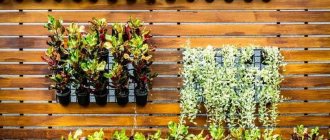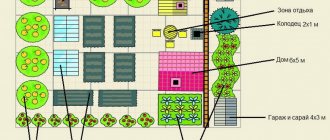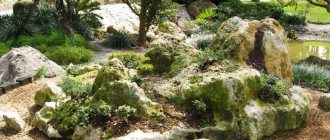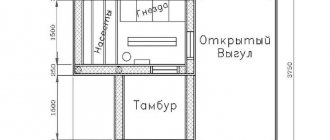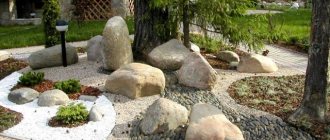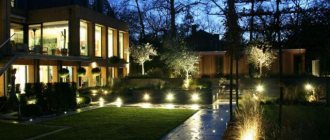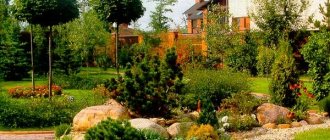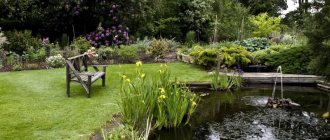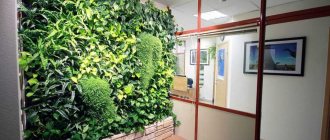- home
- Articles
- Planting material
- Plants for vertical gardening
A modern way to design a site is vertical gardening.
The essence of this method is that vertical supports (walls or other specialized structures) are covered with green mass. In this case, the decorative properties of plants are actively used: the color of their foliage, the presence of lush flowers, bright fruits, etc. Another feature of the breeds used for these purposes is their rapid growth. Therefore, it is possible to achieve powerful decorative effects in a relatively short time. Another serious advantage of this method is the ability to create the effect of voluminous plant masses in small areas. Large spaces visually give the feeling that you are completely surrounded by plantings, while the actual depth of the green wall is very small.
Type of base and choice of planting material for vertical gardening
There are several reasons on the basis of which landscape designers decide on the choice of plants for vertical foundations. First of all, this is the type of architectural form that will be landscaped. Each structure is characterized by its own surface texture, the presence or absence of gaps, and height. For example, brick and stone are rough; plants that have suckers or adventitious roots attach well to them. These are various varieties of ivy, virgin grapes and rooting campsis.
Smooth surfaces will require special support structures on which climbing species will be mounted. There are those that wrap their stems around them. These are honeysuckle and kirkazon. Others, such as clematis, cling to them with leaf petioles. And grapes that have tendrils are able to attach themselves due to them. If you want to use plants for vertical gardening that are not able to be fixed to supports on their own, then you need to be prepared to tie them up. The trees are harmoniously decorated with hydrangea, clematis, honeysuckle, and grapes. Arches and pergolas are decorated with clematis, wisteria, and nightshade. And tripods can be used as a support for ivy, hops, and wood pliers.
Classification of plants according to the methods of their attachment to supports:
- Crops that do not require any additional structures for fastening, as they take root on the walls. Camasas, virgin grapes, ivy, euonymus, petiolate hydrangea, fortunea feel great on the rough surfaces of any buildings (houses, fences, barns, etc.);
- Vines that are attached to supports by leaf petioles or tendrils. Naturally, with this type of fastening, thin elements are needed, around which a delicate tendril or leaf can curl. With tendrils located at the tips of new shoots, clematis, china, pumpkin, kobeya, passionflower, and echinocystis cling to thin stretched threads. It is interesting that after the vine catches on the thread, the tendril wrapped around the support loses its plasticity and becomes lignified. Leafy petioles wrap around supports in species such as clematis, nasturtium, and prince.
- Plants that rest on trellises, trellises, trellises and thus climb up. Thorns and thorns often help in this process. These are bare-flowered jasmine, blackberry, and climbing rose.
- Climbing species that clasp the support with the entire shoot. Depending on their genetic characteristics, they can twine either only around fairly thin branches, or even around thick tree trunks. The growth rate of all crops is also different. The most common in this group are hops, morning glory, ornamental beans, clerodendron, Chinese lemongrass, wisteria, wood pliers, and kirkazon.
Vertical landscaping: design ideas
Vertical landscaping of a site allows you to embody the idea of a paradise on a separate site. The method came from ancient times and was enriched with new ideas of our time.
The following designs and methods are used for vertical gardening:
- Arches . They are most often decorated with vines or roses, and several structures are placed to create a gallery effect.
Arch
- Pergolas . Used as a shady screen canopy, decorated with deciduous vines and hanging hanging plants, it is a cozy place for relaxation and conversation.

Pergola landscaping
- Obelisks . Cylindrical or pyramidal supports entwined with vines or roses. Creates the effect of a lush bush.

Decoration of the site
- Hedges. An excellent solution for zoning a site. Performed using ornamental shrubs. Interesting ideas with evergreen hedges that add decorativeness to the site all year round.
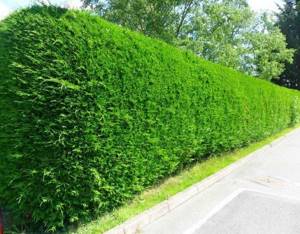
Hedge
- Vertical flower beds. An idea on how to make a flowerbed in a limited area of space. This is done by placing flower pots vertically on reliable supports.
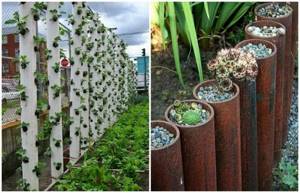
If space is limited
- Hanging models . These are well-known hanging containers with hanging plants. The most commonly used varieties are petunias and begonias.
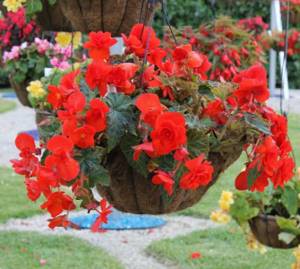
Now you know what you need to do to create the garden of your dreams. Look at your site, assess its size, shape, boundaries, and start planning! Any dream will sooner or later become a reality, you just have to try. Take the first step!
Useful articles for those who want to decorate their interior:
- How to make a phytowall and phytomodules in an apartment
- Modern decor in the living room interior
- Decor for the kitchen in the interior
- How to choose the right interior for an apartment or house
- Apartment interior: top 100 most useful planning tips
- Japanese style in the interior
- High-tech design in the interior
- Schoolchild's room - design, interior design ideas
- Glass furniture in modern interior design
Selecting plants according to their climatic requirements
The choice of plants for vertical gardening is influenced by the location of the supporting walls: light-loving crops that are drought-resistant will feel good on the south side, while shade-loving crops that require moist soil will feel more comfortable on the north side.
Thus, according to the experience of the staff, jasmine, cotoneaster, virgin grapes, forsythia, and ivy feel good in the north. On southern surfaces there are rhododendrons, honeysuckle, clematis, roses, magnolias. In the east you can plant hydrangea, quince, garria, wood-lovers, and in the west - nightshade, ropewort, camellia and broom.
Clematis is universal in this regard: it tolerates both frosts of minus thirty and extreme heat. However, each plant has its own subtleties during cultivation. For example, there are those who do not tolerate drafts and cold winds well. An example is girlish grapes. A special feature of clematis is the need to shade it at the roots. This selective shade-loving behavior is a consequence of its origin, because historically it is a forest species. It is enough to plant a low shrub near a green wall with clematis, and the plant will feel great.
It is worth noting that each species has varieties of varying degrees of unpretentiousness. Typically, hybrids are more delicate and sensitive to cold and heat, although their decorative effect can be more pronounced.
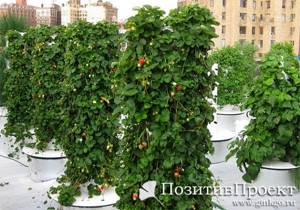
What is good about vertical gardening?
Thanks to the variety of colors, shapes of climbing and climbing plants, colors and textures of their leaves, as well as the ability to be easily trimmed and shaped, a wide variety of design projects can be implemented.

The main advantage of this method of landscaping is the ability to quite quickly and easily decorate large spaces in height and width with living plants.

Dense foliage increases humidity and creates coolness, which is especially valuable during the hot months
Some of the main advantages of this type of landscaping include:
- Maximum decorative effect in a small area. Vertical gardening is an affordable way to decorate buildings, structures and other unsightly utility rooms, as well as create a unique, memorable appearance for structures. Thanks to the use of climbing and climbing plants, it is possible to increase the green area several times while maintaining the scale of the site.
- Easy to care for. Plants for vertical gardening are easy to care for: the need for weeding and mulching of the soil and weed control is eliminated.
- Regulation of thermal conditions. Plants act as a curtain for the building: by reflecting the thermal rays of the sun, they protect its walls from excessive heating. Climbing and climbing plants reduce the penetration of polluted air and dust into the room.
This allows you to use plants for vertical gardening to create cozy corners in the garden, protected from the sun, noise and wind.
A new direction in landscape design can be called living pictures. Read about this:
Selection of vines according to their decorative properties
Crops for vertical gardening have different decorative elements. Some attract landscape designers with lush flowering, others with bright foliage, differently colored in different seasons, and still others with berries.
For example, virgin grapes have climbing shoots with leaves that change color depending on the time of year. In the summer they can be different shades of green, and closer to autumn they change color to red, purple and burgundy. It is characteristic that on the sunny side it has brighter and more intense colors. In autumn, picturesque clusters appear.
Roses, forsythia, jasmine, clematis, honeysuckle are characterized by beautiful flowering. Clematis are distinguished by large flowers. Flowers can be of different colors: white, purple, burgundy, pink, lilac, bluish, etc. Honeysuckle has yellowish-orange inflorescences, which make its planting very decorative in late spring - early summer. In beans, white and red flowers have decorative potential from July to September, and pods appear in the fall.
When choosing a plant for vertical gardening, you need to remember how high a particular species can grow. For example, girl's grapes and actinidia kolomikta can reach a height of 15 meters, clematis - 2-8 meters, kirkazon - 6-8 meters, Thälmann's honeysuckle - 5-6 meters, sweet peas and nasturtium - 1.5-2 meters.
If the surface you are going to decorate is painted in a dark color, then roses are not suitable for decorating it. The fact is that the dark surface will heat up from the sun's rays, and high temperatures will lead to the death of roses.
Blog
What is vertical gardening? Wonder of the world for love! Vertical gardening of the 21st century.
Vertical gardening is a system of landscaping facades with plants in a vertical plane. Vertical gardening is used for a decorative effect on a site and to protect buildings, recreation areas, playgrounds from noise, wind, dust and overheating. The direction in landscape design, which is used for landscaping facades and walls, buildings and structures, can be both outside and indoors. Simply put, for exterior design and interior design.
Our ancestors knew about this seemingly new direction, popular today, as early as 600 BC, when the Hanging Gardens of Babylon were erected in ancient Babylon by order of King Nebuchadnezzar. The design was a pyramid consisting of four tiers-platforms. By the way, the gardens themselves were not hanging, but protruding. Day and night, hundreds of slaves turned a lifting wheel with leather buckets, supplying water to the gardens. And all this was built for the beloved of the Babylonian king Amytis. Therefore, a more correct name for this structure is the Hanging Gardens of Amitis - they are the second most important Wonder of the World. The world's first patent for a vertical phytowall was received by professor from the University of Illinois Stanley Hart White 1931-1938.
In the history of Russia, one of the first examples was the “horse garden” of the Moscow Kremlin. The garden was founded in 1623 by gardener Nazar Ivanov. Today, vertical gardening is strongly associated with the French naturalist designer Patrick Blanc. He created his first composition using the author’s vertical gardening technology in 1994 at the Paris landscape design festival.
Works by Patrick Blanc
With the current development of the urbanization process, the natural environment in cities is changing greatly, and plants in the city help to increase comfort and improve the quality of the urban environment. Therefore, now the use of plants in vertical gardening, the use of natural materials, have a beneficial effect on humans. The life of a city dweller becomes environmentally friendly and comfortable. Connection with nature and vibrant colors are relevant. Vertical gardening creates a feeling of security. There are several types of structures for vertical gardening: a) climbing (wrapping around a support as they grow) b) climbing (fixed by special roots or outgrowths in the form of suction cups) c) clinging (having spinning tendrils) d) leaning (obligatory fixation is required). For different types you need to select your appropriate support. These include lanterns, gazebos, arches, trellises, pillars, etc.
Vertical exterior landscaping
Technology
A specially designed façade greening system can be mounted on almost any vertical surface. The main method of functioning of a vertical garden is based on the achievements of hydroponics (from the Greek hydor - water and pónos - work) - the technology of growing plants without soil in aqueous nutrient solutions.

About plants
Plant growth along a wall can be divided into 2 categories:
- These are climbing plants that grow up the wall, and the root system is in the ground at the base of the wall. – plants in modular panels (on the wall itself), which consist of stainless steel containers, geotextiles, an irrigation system, and a growing medium.
A metal frame with a thin layer of polymer felt with a capillary structure through which water with dissolved fertilizers flows is mounted to the facade of the building. It is in it that seeds and plant seedlings are planted. One of the most important advantages of this method of landscaping buildings is the absence of any trays and pots with soil, traditional for modern hanging gardens, which are mounted at the top of the walls. The entire vertical garden and its weight are reduced to a minimum. The thickness of the “green” wall does not exceed a few centimeters, and its square meter weighs no more than 35 kg. Patrick Blank uses exactly this technology.
Naturally, when choosing an assortment of plants for landscaping, it is necessary to take into account 2 main factors: climatic conditions and appearance. So, for the exterior, unpretentious perennial plants and annuals can be used, which allow you to paint real multi-colored tapestries on the walls. Traditional indoor plants can be used for the interior.
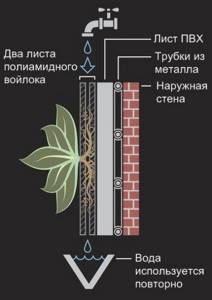
Exterior and interior have some differences:
For exterior (street) decoration and vertical gardening, the following types of devices are used: trellises, flower stands, flowerpots and frames. Trellis - light wooden or metal structures in the form of a lattice for landscaping with climbing or supporting plants, used to organize quiet rest areas, shelter from the sun, fencing areas, technical devices and structures. Flower pots and flowerpots are small containers with plant soil in which flower plants are planted. Frame - can be made in several ways, for example: a) Frame in the form of a mesh. b) Frame in the form of a built-in rack. c) Frame in the form of a portable or stationary rack with guides.
For outdoor landscaping you can use: – annual – perennial plants, – herbs – garden crops
Vertical interior gardening
For interior vertical gardening they use: – Live plants – there is a large assortment of indoor plants that are not used in outdoor landscaping. – Artificial – artificial ones have many advantages, they maintain an impeccable appearance throughout their entire service life, and this period for artificial plants is almost endless. The leaves and flowers of artificial flowers and trees will never turn yellow, dry out, break or fall off. And with the achievement of new production technologies, such flowers are no different from living ones. – Stabilized are natural plants in which, as a result of special processing, the natural juice is replaced with a special solution based on glycerin. Technologies make it possible to subject almost all plants used by florists to such treatment, while stabilized materials are distinguished by unique strength and elasticity, and in appearance they are completely indistinguishable from natural ones. In turn, stabilized plants come in two types: flowers and moss. – Spicy herbs and garden crops are both useful and decorative decoration for the interior. – Dried flowers are not very durable, but using decorative dried plants, you can create not only classic bouquets of ears of corn and twigs, but also wall paintings and a herbarium.
For different styles of landscape design, you can choose your own unique assortment, taking into account the biological characteristics of plants. Here is a list of the most commonly used plants in WHO Light-loving plants: sweet pea, morning glory, kobea, nasturtium, magnolia grandiflora petunia, bidens, lobularia, clematis, honeysuckle, ceanothus, calistemon, pelargonium, bacopa, actinidia, climbing rose, rhododendron, wisteria, rooting campis . Shade-tolerant: clematis, virgin grapes, ivy, camellia, cotoneaster, small-leaved jasmine, drooping forsythia, elliptical garia, Amur grapes. Partial shade: begonia, lobelia, virgin grapes, actinidia, lemongrass, clematis climbing hydrangea, honeysuckle.
Perennial vines for central Russia - five-leaved maiden grape - five-leaved vineyard (Ampelopsis) - Amur grape - actinidia kolomikta - Manchurian kirkazon - clematis With the help of vertical gardening, you can qualitatively form your own plot, decorate the dullness of buildings, and also organize an excellent place for outdoor recreation .
The desire for environmental friendliness, natural materials set the tone in everything; in Europe large spaces and entire walls of buildings are being planted with greenery. Such gardens on the wall may soon appear in Moscow; the walls of residential buildings on Arbat will be decorated. They plan to plant the walls with multi-colored Scandinavian mosses. In the future, the city authorities intend to plant plants not only on blank walls, but also on facades with windows and balconies. But Russian designers also prefer to experiment indoors, which is why many landscape campaigns now offer interior greenery. Phytowalls, phytomodules and phytopictures have come into fashion.
Style features of plants for vertical gardening
Vertical gardening can enhance any style of garden. But in each specific style option, different types will be in demand. For example, for minimalist solutions, crops with decorative foliage, without the unnecessary luxury of flowers and fruits, are ideal. For the most decorative styles, such as Art Nouveau, exquisite flowers on green walls will be a must. The priority will be sinuous forged supports with decor in the form of insects or birds.
There are styles in which vertical gardening plays the leading role. For example, in eco-style it allows you to hide fences, outbuildings, and drape the walls of a house. As a result, all buildings and structures fit into the environment as much as possible and merge with it. For an eco-style garden, it would be correct to choose plants that are characteristic of the ecosystem of the area where the site is located. In mid-latitude estates, ivy and maiden grapes look very organic.
Vertical landscaping: advantages
Vertical landscaping has been known to mankind for a long time - from the Hanging Gardens of Babylon of ancient Babylon, medieval castles covered with ivy, to the present day. The trend has not lost its relevance; modern designers have added many new ideas to ancient methods.
The advantages of vertical gardening of the site are its capabilities:
- cover unsightly places on old buildings or facades;
- revive the blank walls of houses;
- decorate boring fences picturesquely
- protect your recreation area from the prying eyes of neighbors;
- zone the site at the lowest cost;
- improve microclimate and air humidity;
- create a special psychological mood for a good rest.
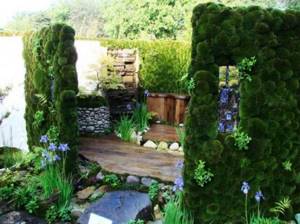
Design
Plants for hydroponic landscaping
What is hydroponics and how is it used in modern gardening?
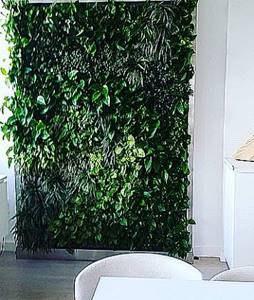
One of the most common ways to use plants in landscaping until recently was the hydroponic method.
When creating green walls from plants based on the hydroponics method, plants are planted in felt pockets or plastic containers filled with some neutral substrate (for example, perlite).
Planting is also possible without using a substrate - in this case, the roots of the plants are wrapped in moss to create vertical gardening. When using this method, plants are prepared in a special way for planting: the roots are completely washed from the soil, and only then immersed in a neutral substrate or wrapped in moss.
Since there is virtually no nutrient medium for plant growth when using this method, a nutrient solution is poured through the automatic watering system twice a day, which waters and nourishes the plants in vertical gardening.
The advantage of this method is that the finished vertical structure of plants is much lighter in weight than, say, a structure using natural soil. However, there are also disadvantages.
The first disadvantage of vertical gardening is that the nutrient solution quickly clogs the tubes of the automatic watering system and you have to change them.
The second disadvantage: due to the fact that water flows over fabric (felt) or plastic several times a day, mushrooms and mosses form on the surface, which must be removed in a timely manner.
The third disadvantage: water in a vertical gardening system constantly circulates in a vicious circle, which increases the risk of disease transmission from one plant to another.
The fourth, biggest disadvantage: based on recent research, this method is recognized as hazardous to health and is not recommended for use in residential premises.
What is the danger to plants? The fact is that the use of plants in gardening using the hydroponic method requires the presence of a chemical solution that is poured through the system at least twice a day. This solution evaporates into the surrounding air and can be harmful to human health. for example, cause allergies. Therefore, we do not recommend using the hydroponic method when gardening indoors.
Plants for landscaping on the ground
This method is currently the most relevant, because modules filled with nutrient soil are used as the basis for planting plants, and therefore this method is more environmentally friendly and not dangerous to human health, unlike hydroponics.
Modules can be made of plastic or felt: the choice of module for a vertical rack depends on the specific design decision of the construction contractor.
This design, as in the case of hydroponics, assumes the presence of an automatic watering system that supplies water to the modules at a given watering schedule. Currently, Russian manufacturers of equipment for vertical gardening produce fairly large modules, with a volume of 10 liters, in which not only small but also larger plants can be planted, which has now increased the list of plants that can be used to create a vertical green structure.
If you decide that you need plants to be planted in the form of vertical gardening, which will occupy a living space, then you definitely need to choose a more environmentally friendly method - this is the “on the ground” method.
Selection of plants depending on the cardinal directions
The main determining factor in the optimal choice of plant for decorating the facade of a structure is the side of the world towards which the landscaping object faces.
For the northern walls of the building, the following are perfect: virgin grapes, chaenomeles, ivy, camellia, mock orange, forsythia, elliptical garria, beautiful capuchin, horizontal cotoneaster.

Easily rooted and unpretentious in care, virgin grapes are capable of braiding fairly large surface areas in 1-2 years.
On the southern walls the following will appear in all their glory: honeysuckle, clematis, wisteria, rhododendron, ceanothus, broom, campsis, callistemon, climbing rose, Chinese schizandra, actinidia kolomikta.
Feel comfortable on the eastern side of buildings: nasturtium, pyracantha, Japanese kerria, tree hydrangea, large-leaved tree pliers, as well as such favorites of the sun as virgin grapes, clematis, ivy, chaenomeles.
Recent Entries
5 working ways to use tar in the garden 7 indoor plants that help you get married even in adulthood Indoor plants that can bloom in trouble
The western part of the wall can be decorated with: nightshade, hops, blue passionflower, grapevine, magnolia grandiflora, Californian carpenteria, as well as varieties of camellia, wisteria, and hionanthus.

Clematis vines with lush greenery will add delicacy to any design, and gorgeous flowers of the most incredible shades will delight throughout the summer
If we take as a basis the design features that are planned to be decorated in an original way with living plants, then the following are ideal for decorating arches and pregoles: honeysuckle, clematis, curly nightshade, as well as various types of clematis, wisteria, and beautiful roses.
You can learn more about how to create a garden arch for flowers from the material:

Roses are favorites in popularity among gardeners: climbing varieties effectively decorate all kinds of arches and pergolas
For decorating trees, it will be very successful to use: Coigne grapes, clematis (Tagun and mountain), honeysuckle, scaly hydrangea.
For good development and abundant flowering, both climbing and climbing plants require fertile, slightly acidic soil.

When designing a structure, it is advisable to use only similar types of plants in a small area, which will avoid excessive diversity of thickets and a chaotic picture devoid of harmony.
Material about the most unpretentious varieties of climbing plants will also be useful:
